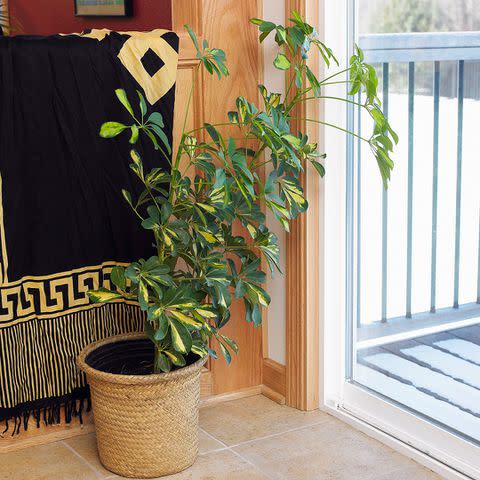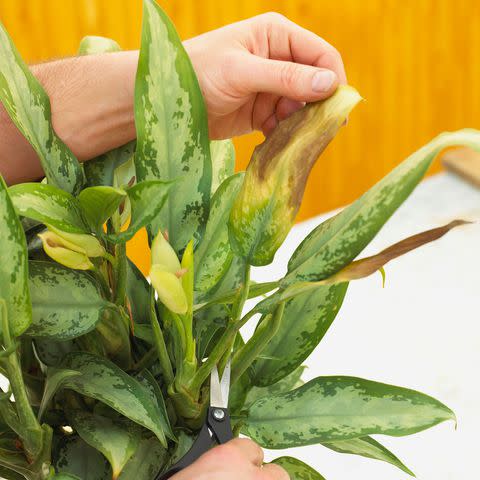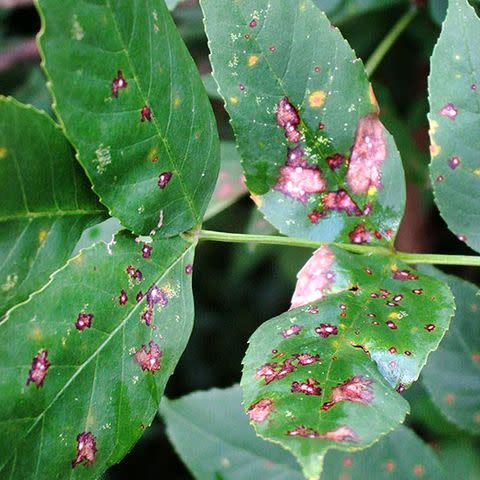How to Fix 10 Common Houseplant Problems
Find solutions for wilting, yellowing leaves, and other worrying symptoms on your houseplants.
One of the most frustrating things about houseplants occurs when a normally healthy plant starts looking sick—perhaps it wilts, drops its leaves, turns yellow, or worse—and you're not sure why. You might think it's game over, but many plant problems can be resolved with small care changes. Coax your houseplant back to life from weak growth, brown leaf tips, fertilizer burn, and more by learning how to tell if you're underwatering, overwatering, or your plant isn't getting enough light.

Here's how to deal with 10 common houseplant problems so you can get back to enjoying your thriving, happy indoor jungle again.
1. Problem: Stretching

Jason Donnelly
Solution:
If your houseplant has started getting leggy and awkwardly tall or is sending out spindly, weak stems reaching toward a light source, it's trying to tell you that it needs more light. Move it closer to a window or switch it to another window that gets more light. South-facing windows tend to be the brightest, north-facing windows offer the least light, and east and west windows fall somewhere in between. And rotate your plants so that all sides of the plant get equal access to the sun and prevent the houseplant problem of lopsided growth. If you still can't find the perfect spot for the plant, invest in a grow light to make sure it gets what it needs.
:
2. Problem: Curling Leaves
Solution:
Unusual growth patterns are a common sign of disease or insect presence. If you see curling or distorted leaves, look closer—you may find other signs of insects or the insects themselves. If you find black spots or fuzzy white spots, it's probably a disease. Use your fingers to crush pests or treat your plant with neem oil. If your plant has a disease, remove affected areas to prevent further spread.
3. Problem: Brown Leaf Tips
Solution:
If your houseplant problem is brown tips on its leaves, it may be signaling one of the following issues:
Inconsistent watering: This doesn't mean you must constantly water your houseplants at 9 am on a Tuesday. Instead, be sure to only water when a plant really needs it. And even if your plant can tolerate less frequent watering, try not to go weeks without watering and then randomly surprise it with a well-intentioned deluge. When you water, make sure water runs out of the drainage holes, so you know it's not a) sitting in the pot or b) only reaching the top part of the plant.
Too much salt: This can happen from overfertilizing or salts from treated tap water. Either flush the soil with water until it drains out clear or repot your plant into fresh potting mix. Then, go easy on the fertilizer and try watering with distilled water.
Low humidity: Many houseplants are tropical natives. If the air in your house or apartment is dry, place a humidifier nearby.
:
4. Problem: Yellow Leaves
Solution:
If your plant only has one or two yellow leaves, it's likely not serious—just pluck them off, and your plant should be good to go. An excessive amount of yellow leaves, however, could be a sign of a more significant issue. Overwatering kills houseplants just as often (if not more) than underwatering. Although exact needs vary by plant, a good rule of thumb is to water when the soil feels dry about 1/2 to 1 inch down. And most houseplants shouldn't sit in water because constantly wet soil leads to root rot. To avoid this problem, only use containers with drainage holes and empty water from saucers beneath them.
Yellowish leaves all over the plant may also be a sign of too little light. Try moving the plant to a brighter spot.
5. Problem: Dropping Leaves
Solution:
Are you constantly having to pick up leaves from the floor when you walk by your plant? Some plants, such as ficus, are sensitive to a change in location and show it by dropping leaves. As long as the growing conditions in the new spot are still ideal, it should grow fresh leaves after it settles in. If you haven't moved your plant recently, leaf drop may also indicate low light.
:
6. Problem: Pale or Burnt Leaves

Dean Schoeppner
Solution:
Like humans, your plant can get sunburned. Leaves that are pale or white are usually a result of too much light. Luckily, this is easily resolved by moving your plant out of direct sunlight or to a window that gets less intense light. Leaf scorch can also be a result of fertilizer burn. Use less fertilizer or switch to distilled water, as the salt from softened faucet water can build up in the soil.
7. Problem: Wilting Leaves
Solution:
The plant problem wilt can be challenging to diagnose; sometimes, it can be too late to save your plant. It may be caused by underwatering, overwatering, poorly draining soil, heat stress, disease, or a lack of humidity. You can try to bring your plant back from the brink by checking the soil for dampness or dryness and adjusting watering habits accordingly, lowering the temperature, repotting in better soil, or misting to improve humidity.
8. Problem: Spotted Leaves

Denny Schrock
Solution:
Spots on leaves are often caused by a plant disease. You may be able to salvage the plant by improving air circulation so that it dries out more quickly between watering and removing diseased foliage. Throw away any diseased plant material so it doesn't spread to other plants. To prevent disease, give plants ample space to grow, remove dead foliage promptly, and always water at the base of a plant.
9. Problem: Powdery Mildew
Solution:
Powdery mildew is a fungal infection that affects many plants. It's easiest for mildew to form in still, humid conditions, so increasing the airflow around the affected plant can also help. Remove the severely infected foliage when working on controlling the issue.
10. Problem: Nonabsorbent Soil
Solution:
If you're confident you're giving a plant plenty of water, and it's not root-bound (two common reasons for plants to dry out), your houseplant problem may be an issue with your soil. Many potting soils use peat, which holds water well when moistened but is difficult to wet the first time thoroughly. Even if it's been well-moistened in the past, leaving the plant unwatered when you go on vacation or forgetting to water it regularly can dry out the soil to the point where it's difficult to rehydrate.
Small pots can be submerged in lukewarm water to re-moisten the peat in the soil. It's more challenging to do that with large pots. Many nurseries sell surfactants (wetting agents) that are safe for the plant. Follow the instructions on the bottle to fix your soil.